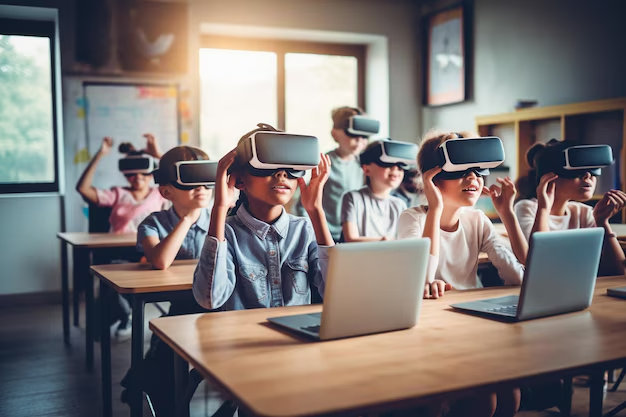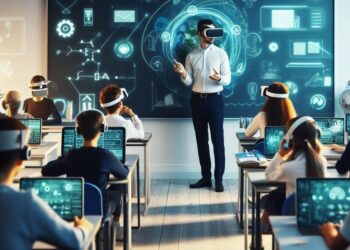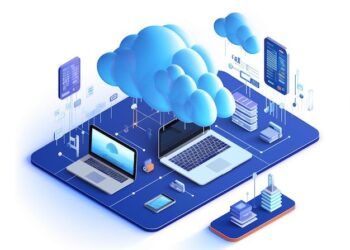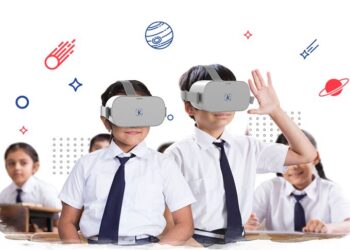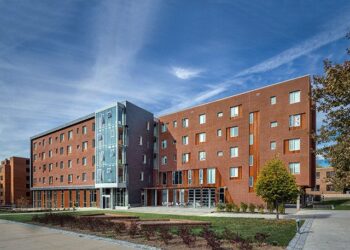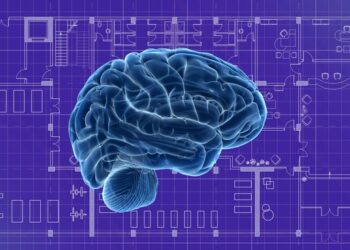The educational landscape is undergoing a revolutionary transformation as virtual reality (VR) technology emerges as a powerful catalyst for enhancing Science, Technology, Engineering, and Mathematics (STEM) education. This cutting-edge technology is reshaping how students interact with complex concepts, providing unprecedented opportunities for immersive learning experiences that were previously impossible in traditional classroom settings.
The Digital Revolution in Educational Methodology
Modern educational institutions are increasingly recognizing the limitations of conventional teaching approaches, particularly in STEM subjects that often involve abstract concepts and complex theoretical frameworks. Virtual reality technology addresses these challenges by creating three-dimensional, interactive environments where students can visualize, manipulate, and experiment with concepts that would otherwise remain theoretical.
The integration of VR technology in educational settings represents more than just a technological upgrade; it signifies a fundamental shift in pedagogical approaches. This transformation is particularly significant in STEM fields, where students frequently struggle with abstract mathematical concepts, invisible scientific processes, and complex engineering principles that are difficult to demonstrate through traditional methods.
Research conducted by leading educational institutions has consistently demonstrated that students retain information more effectively when they can interact with content through multiple sensory channels. Virtual reality leverages this principle by engaging visual, auditory, and kinesthetic learning modalities simultaneously, creating a comprehensive educational experience that caters to diverse learning styles.
Comprehensive Benefits of VR Implementation in STEM Education
A. Enhanced Conceptual Understanding
Virtual reality technology enables students to explore microscopic worlds, witness chemical reactions at the molecular level, and observe astronomical phenomena that would be impossible to experience in real-time. This capability transforms abstract concepts into tangible experiences, making complex scientific principles more accessible and comprehensible.
Students can navigate through the human circulatory system, observe planetary movements in real-time, or manipulate three-dimensional molecular structures. These immersive experiences create lasting impressions that traditional textbook illustrations or static diagrams cannot achieve.
B. Risk-Free Experimentation Environment
One of the most significant advantages of VR in STEM education is the ability to conduct potentially dangerous or expensive experiments in a completely safe virtual environment. Students can handle radioactive materials, perform complex surgical procedures, or experiment with volatile chemical compounds without any physical risk.
This risk-free environment encourages experimentation and exploration, allowing students to learn from mistakes without consequences. The ability to repeat experiments multiple times also reinforces learning and helps students understand cause-and-effect relationships more clearly.
C. Cost-Effective Laboratory Solutions
Traditional STEM education often requires expensive laboratory equipment, specialized materials, and extensive safety protocols. Virtual reality provides cost-effective alternatives that deliver comparable educational value without the associated expenses and logistical challenges.
Educational institutions can provide students with access to advanced laboratory equipment and rare materials through VR simulations, democratizing access to high-quality STEM education regardless of budget constraints or geographical limitations.
D. Personalized Learning Experiences
VR technology enables the creation of adaptive learning environments that adjust to individual student needs and learning paces. Students can progress through material at their own speed, receive immediate feedback, and access additional resources when needed.
This personalization extends to different learning styles, allowing visual learners to see concepts in action, kinesthetic learners to manipulate objects, and auditory learners to receive detailed explanations throughout their virtual experiences.
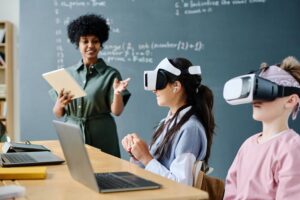
Specific Applications Across STEM Disciplines
A. Science Education Applications
In biology classes, students can take virtual field trips to ecosystems around the world, exploring rainforests, coral reefs, and arctic environments without leaving the classroom. They can also journey inside the human body, observing organ functions and biological processes in real-time.
Chemistry students benefit from VR applications that allow them to build molecular structures, observe chemical bonding processes, and conduct virtual experiments with dangerous or expensive materials. These experiences help students understand atomic and molecular interactions that are invisible to the naked eye.
Physics education is enhanced through VR simulations that demonstrate wave properties, electromagnetic fields, and quantum mechanics concepts. Students can visualize abstract physics principles and observe how changing variables affects experimental outcomes.
B. Technology and Computer Science Integration
VR technology naturally integrates with computer science education, providing students with hands-on experience in programming, software development, and digital design. Students can create their own virtual environments while learning programming languages and software engineering principles.
Information technology courses benefit from VR applications that simulate network configurations, cybersecurity scenarios, and database management systems. These simulations provide practical experience without the need for expensive hardware infrastructure.
C. Engineering Design and Visualization
Engineering students can use VR technology to design, test, and modify structures, machines, and systems in virtual environments. This capability allows for rapid prototyping and testing without the costs associated with physical materials and manufacturing.
Civil engineering students can walk through virtual building designs, identify potential structural issues, and experience how their designs would function in real-world conditions. Mechanical engineering students can observe how machines operate and identify optimization opportunities.
D. Mathematics Visualization and Problem-Solving
Mathematics education benefits significantly from VR applications that transform abstract mathematical concepts into visual, interactive experiences. Students can explore geometric shapes in three dimensions, visualize statistical data, and interact with mathematical functions in ways that traditional methods cannot provide.
Calculus concepts become more accessible when students can visualize derivatives and integrals in three-dimensional space. Algebra students can manipulate equations and observe how changes affect graphical representations in real-time.
Implementation Strategies for Educational Institutions
A. Infrastructure Development Requirements
Successful VR implementation requires careful planning and adequate technological infrastructure. Educational institutions must consider hardware requirements, including VR headsets, powerful computers, and reliable internet connectivity. The initial investment may be significant, but the long-term educational benefits and cost savings often justify the expense.
Network infrastructure must be robust enough to support multiple simultaneous VR sessions without performance degradation. Cloud-based solutions can help reduce local hardware requirements while providing access to extensive VR content libraries.
B. Educator Training and Professional Development
Teachers and instructors require comprehensive training to effectively integrate VR technology into their curricula. Professional development programs should focus not only on technical skills but also on pedagogical strategies for maximizing the educational impact of VR experiences.
Ongoing support and training ensure that educators remain current with evolving VR technologies and can troubleshoot common issues independently. Collaboration between technology specialists and subject matter experts creates more effective implementation strategies.
C. Curriculum Integration Methodologies
VR technology should complement rather than replace traditional teaching methods. Effective implementation involves identifying specific learning objectives that benefit from VR enhancement and developing integrated lesson plans that combine virtual and traditional learning experiences.
Assessment strategies must evolve to evaluate student learning in VR environments effectively. New metrics and evaluation methods may be necessary to capture the full impact of immersive learning experiences on student understanding and retention.
D. Student Accessibility and Inclusion
Implementation strategies must consider accessibility requirements for students with disabilities, ensuring that VR experiences are inclusive and provide equal learning opportunities for all students. Alternative interaction methods and adaptive technologies may be necessary to accommodate diverse needs.
Digital equity considerations ensure that all students have access to VR technology regardless of socioeconomic background. Lending programs, shared devices, and partnerships with community organizations can help bridge technology gaps.
Overcoming Implementation Challenges
A. Technical Limitations and Solutions
Current VR technology faces certain limitations, including resolution constraints, motion sickness in some users, and hardware compatibility issues. However, rapid technological advancement continues to address these challenges with improved hardware and software solutions.
Regular updates and maintenance are essential for optimal VR system performance. Technical support teams must be prepared to address hardware malfunctions, software conflicts, and user experience issues promptly.
B. Budget Constraints and Funding Strategies
The initial cost of VR implementation can be substantial, particularly for schools with limited budgets. Grant opportunities, corporate partnerships, and phased implementation strategies can help institutions manage costs while building comprehensive VR programs.
Sharing resources between institutions, bulk purchasing agreements, and leasing arrangements can reduce individual institutional costs while providing access to cutting-edge VR technology.
C. Resistance to Change Management
Some educators and administrators may resist adopting new technologies due to comfort with traditional methods or concerns about effectiveness. Change management strategies should include demonstration sessions, pilot programs, and clear communication about benefits and expected outcomes.
Success stories and measurable improvements in student engagement and learning outcomes help build support for VR implementation initiatives. Involving skeptical stakeholders in planning and evaluation processes can address concerns and build confidence.
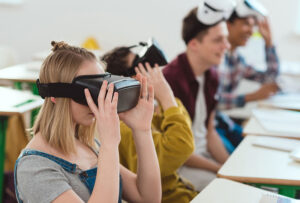
Future Trends and Technological Evolution
A. Artificial Intelligence Integration
The convergence of VR and artificial intelligence technologies promises even more sophisticated educational experiences. AI-powered virtual tutors can provide personalized guidance, adaptive content delivery, and real-time assessment within VR environments.
Machine learning algorithms can analyze student behavior and learning patterns to optimize VR experiences continually. This data-driven approach ensures that virtual learning environments become more effective over time.
B. Haptic Feedback and Sensory Enhancement
Emerging haptic technologies will add tactile sensations to VR experiences, allowing students to feel textures, temperatures, and resistance when interacting with virtual objects. This sensory enhancement will make VR experiences even more realistic and educationally valuable.
Advanced haptic systems will enable students to perform delicate procedures, manipulate microscopic objects, and experience physical properties of materials in virtual environments.
C. Collaborative Virtual Learning Spaces
Future VR platforms will support sophisticated collaborative learning experiences, allowing students from different geographical locations to work together in shared virtual laboratories and classrooms. These collaborative spaces will expand access to specialized expertise and diverse perspectives.
Social learning features will enable peer-to-peer instruction, group problem-solving, and collaborative project development within immersive virtual environments.
D. Extended Reality (XR) Integration
The evolution toward extended reality, which combines virtual reality, augmented reality, and mixed reality technologies, will create even more versatile educational tools. XR platforms will allow seamless transitions between virtual and real-world learning experiences.
This integration will enable students to overlay virtual information onto physical objects, creating hybrid learning environments that combine the benefits of both digital and physical manipulation.
Measuring Success and Educational Outcomes
A. Assessment Methodologies and Metrics
Evaluating the effectiveness of VR in STEM education requires new assessment approaches that capture both quantitative learning outcomes and qualitative engagement metrics. Traditional testing methods may not fully reflect the depth of understanding achieved through immersive experiences.
Performance analytics within VR environments can provide detailed insights into student learning processes, including time spent on tasks, problem-solving approaches, and areas of difficulty. This data enables more targeted interventions and personalized support.
B. Long-Term Impact Analysis
Longitudinal studies are necessary to understand the lasting impact of VR-enhanced STEM education on student retention, career choices, and continued learning motivation. These studies will help refine implementation strategies and justify continued investment in VR technology.
Tracking student progress through subsequent courses and career development provides valuable feedback on the effectiveness of VR educational experiences in preparing students for advanced study and professional success.
Conclusion: The Transformative Potential of VR in STEM Education
Virtual reality technology represents a paradigm shift in STEM education, offering unprecedented opportunities to enhance student engagement, understanding, and retention. As educational institutions continue to adopt and refine VR implementation strategies, the potential for transforming how students learn complex scientific and mathematical concepts becomes increasingly apparent.
The success of VR in STEM education depends not only on technological advancement but also on thoughtful implementation, adequate support systems, and ongoing evaluation of educational outcomes. As costs decrease and technology improves, VR will become an increasingly accessible and valuable tool for educators worldwide.
The future of STEM education lies in embracing innovative technologies that complement traditional teaching methods while addressing the unique challenges of 21st-century learning. Virtual reality provides a powerful platform for creating engaging, effective, and inclusive educational experiences that prepare students for success in an increasingly technological world.
Educational institutions that proactively integrate VR technology into their STEM programs will be better positioned to attract students, improve learning outcomes, and prepare graduates for careers in rapidly evolving technological fields. The investment in VR technology today represents an investment in the educational success of tomorrow’s scientists, engineers, and innovators.

